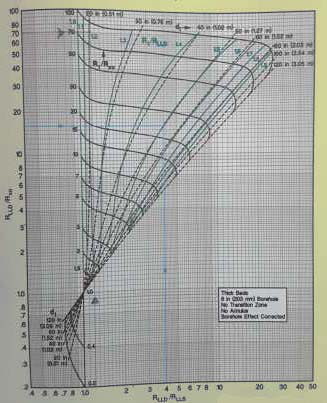Site Navigation
Oilfield expertise at your desktop
Resistivity environmental corrections
Resistivity tool responses generally must be corrected for a variety of factors; namely, borehole effects, bed thickness, and invasion. Micro-resistivity measurements must be corrected for the presence of mudcake. Resistivity corrections are particular to tool type,correct tool type needs to be specified for proper correction.
Furthermore, resistivity corrections must be performed in a particular order because one corrected value is used to make the next required correction. This can be best learned by applying correction manually ,each resistivity section of the chart book is arranged in such a way that the charts appear in sequence. For any resistivity tool, environmental corrections should be undertaken in the following order:
1.Borehole correction of the shallow device on induction tool, or mudcake correction for pad-mounted micro-resistivity electrode (MSFL).
2.Borehole correction for deep and medium devices.
3.Bed thickness correction for deep and medium devices.
4.Invasion correction.
The ultimate goal in performing resistivity environmental corrections is to calculate resistivity of the uninvaded zone (Rt), resistivity of the flushed zone (Rxo), and
diameter of invasion (di). These three unknowns are determined in the final step
of the process (i.e. invasion correction). Invasion corrections assume conditions of infinitely thick homogeneous beds and an 8-inch borehole; therefore, both borehole and bed thickness corrections must be applied to input measurements before applying invasion correction.
Micro sphericaly focussed log (MSFL) environment correction:
The Micro-resistivity measurement of the MSFL is often considered to be an accurate
measure of flushed zone resistivity (Rxo). However, any measure of flushed zone
resistivity by a pad-mounted device will be influenced by the presence of mudcake and hence there is a need to apply mudcake correction on MSFL curve to get Rxo.
Since MSFL is a pad mounted contact device, it is sensitive to mud cake thickness (hmc) and mud cake resistivity (Rmc).
Rmc needs to be estimated from mud resistivity and hmc can be obtained using caliper and bitsize.
Deep and medium resistivity correction:
There are borehole correction ,bed thickness correction and invasion correction for deep and and shallow resistivity.
Borehole correction: This correction is not very significant in case resistivity tools except in case of very bad hole.
Bed thickness correction: When a resistivity tool sonde is in front of a bed which has different conductivity then the beds above and below, the measured current tends to concentrate in the least resistive path, if the shoulder beds have lower resistivity then the bed of interest, the measured resistivity value will be to low. Conversely, if the shoulder beds have higher resistivity then the zone of interest, the measured resistivity will be too high.
Invasion correction:- After correcting for borehole effect and bed thickness effect invasion diameter is calculated along with true resistivity and flushed zone resistivity using butterfly /tornado chart.
